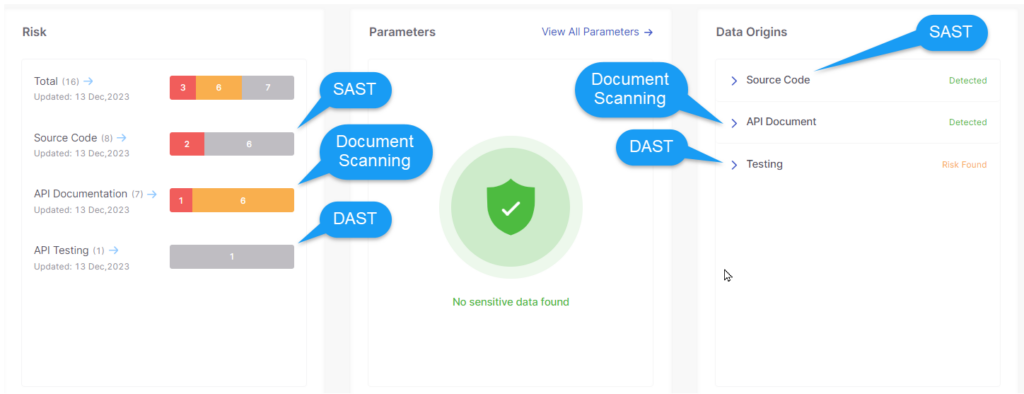
The intersection of technological innovation and application security is critical today. As businesses continue their digital transformation journey, application security testing (AST) can often emerge as a potential bottleneck, stunting the pace of progress, which can often put developers and CISOs at odds with each other. When deploying multiple AST tools, organizations must carefully manage different workflows, policies, and procedures.
A great example of this complexity is the often-siloed use of Static Application Security Testing (SAST) and Dynamic Application Security Testing (DAST). Since separate teams typically manage each solution with distinct tools and processes, the resulting back and forth often hinders the pace of innovation, and can impede effective communication and collaboration across teams. Further, the task of correlating findings from these different tools can become overwhelming, especially when vulnerabilities’ severity can differ across platforms.
SAST & DAST – The Way It’s Been
Traditionally, SAST and DAST have filled distinct roles in the security space. SAST is entwined with the development process and offers an “under-the-hood” inspection of the source code, that identifies potential vulnerabilities early in the development lifecycle. DAST, often the mainstay of penetration testers and security teams, assesses applications during runtime, uncovering vulnerabilities that only become evident post-deployment.
In a conventional setup, separate teams handle SAST and DAST, each equipped with unique tools and methodologies. The real challenge unfolds during the triage process—interpreting and prioritizing these findings in real-world scenarios. For example, from a DAST-surfaced endpoint, deciphering which part of the code is vulnerable, or deciding whether to devote resources to fix a complex vulnerability, necessitates a delicate balance between the potential impact and exploitation likelihood.
SAST is like an x-ray of your code. It allows you to identify vulnerabilities early in the SDLC, as well provides great code coverage. It allows us to build applications in a fast and automated manner.
Overlaps exist between SAST and DAST. For example, parameters or configurations in the HTTP protocol. In this case, we may reduce testing scenarios in one engine and add it in the other or we can complement each analysis by confirming SAST results in DAST scanning, increasing certainty and prioritization.
So – instead of multiple processes and timelines, that can often lead to confusion, muddled communication, and frustration, what if we explored something different? Consolidating SAST and DAST on one platform.
SAST & DAST – The Way It Should Be
This combination eliminates the need to constantly switch between different tools or manage individual users and multiple onboarding processes. Instead, a unified platform becomes a centralized hub for security testing, with one project, one set of policies, and a harmonized knowledge base. It brings DAST scans into the fold of the code check-in process, fostering the seamless correlation of vulnerabilities identified by both SAST and DAST. For example, SAST may identify API endpoints in the code and use that information in DAST for testing those endpoints.
But the real benefit of a single platform is the transformative effect it has on team structure and collaboration. A unified platform allows for one project to be configured for both SAST and DAST on the same repository, enhancing inter-team communication. Moreover, it facilitates the creation of a comprehensive application security team that is well-versed in handling both SAST and DAST. This is a significant leap from the traditional, siloed approach of having separate teams that can often find themselves at odds with each other.
This unified approach allows teams to cultivate a deeper sense of ownership and responsibility. When every member of your AppSec team has an in-depth understanding of the security landscape, it enables them to respond swiftly and efficiently to threats. Over time, your team can evolve into a formidable force, capable of anticipating and mitigating security risks, ensuring a secure environment that fuels relentless innovation. This fosters a culture of shared knowledge and cooperation, vital for navigating the complex landscape of application security.
This powerful amalgamation of SAST and DAST is more than just administrative convenience—it empowers organizations to innovate fearlessly with a comprehensive security safety net. With a unified approach, organizations can confidently drive technological advancement without compromising security. This shift in focus, from maintaining security to harnessing its potential to propel business success, is a game-changer. In embracing this unified approach to application security testing, organizations take a giant stride towards a future where innovation and security harmoniously coexist, fueling an era of fearless innovation.
What does this look like on Checkmarx One?
With the Checkmarx One Platform, you can manage your application security in one place.

When a new application is onboarded, all its settings can be managed and performed in one place, by one AppSec team. Historically, organizations would manage separate SAST and DAST teams, with separate meetings, and specific integrations for each instance – but now with Checkmarx One, you can do everything on one platform with the following benefits:
Integration: Integrations are carried on at a platform level, so now multiple analysis’ can be performed when a single event triggers multiple scans. The results are also consolidated in the same ticketing system.
Automation: Speed is one of the fundamental principles of DevOps. In a continuous integration and deployment (CI/CD) environment, the speed with which you can get code out and into production beats almost anything else.
More visibility: On the Checkmarx One platform, you will have a 360-degree view of the security of your application, along with the ability to truly understand all the information presented. Transparency is key for being able to see what is truly happening within your applications.
Correlation & Consistency: Correlation allows you and your team to triage better and prioritize faster and with more precision. Consistency allows you and your team to avoid the problem of having multiple compliance reports, processes, remediation times, and priorities. With our platform, you have a holistic view of the security posture of your application no matter which scanning engines are involved.
Want to learn more? Contact us to see how SAST and DAST works together on the Checkmarx One platform.
The post Unifying SAST and DAST: The Key to Fostering Fearless Innovation appeared first on Checkmarx.com.
Article Link: Unifying SAST and DAST